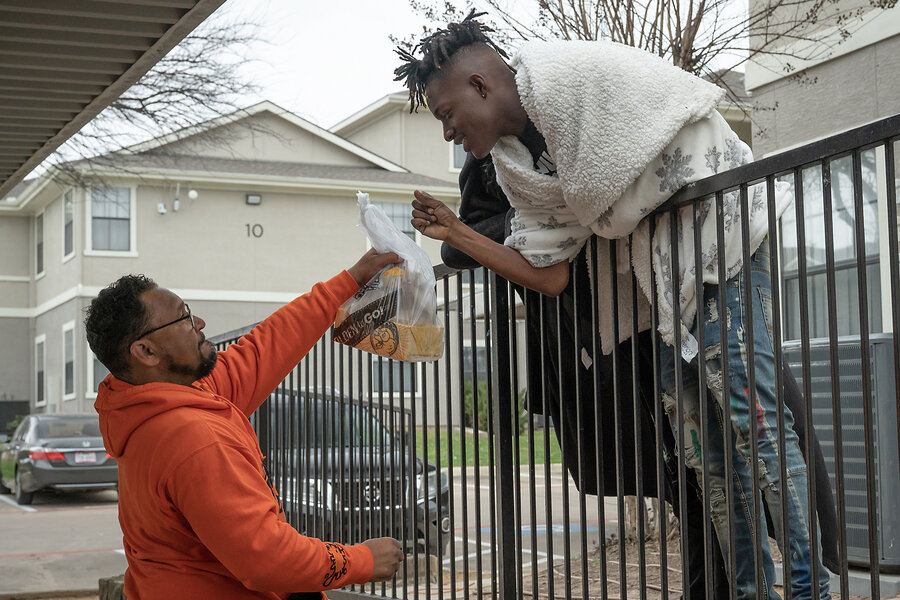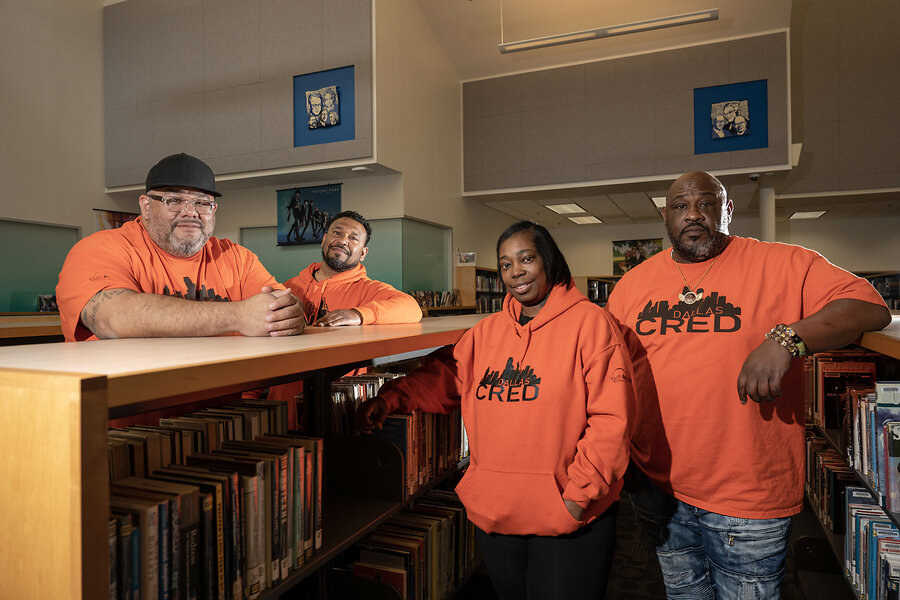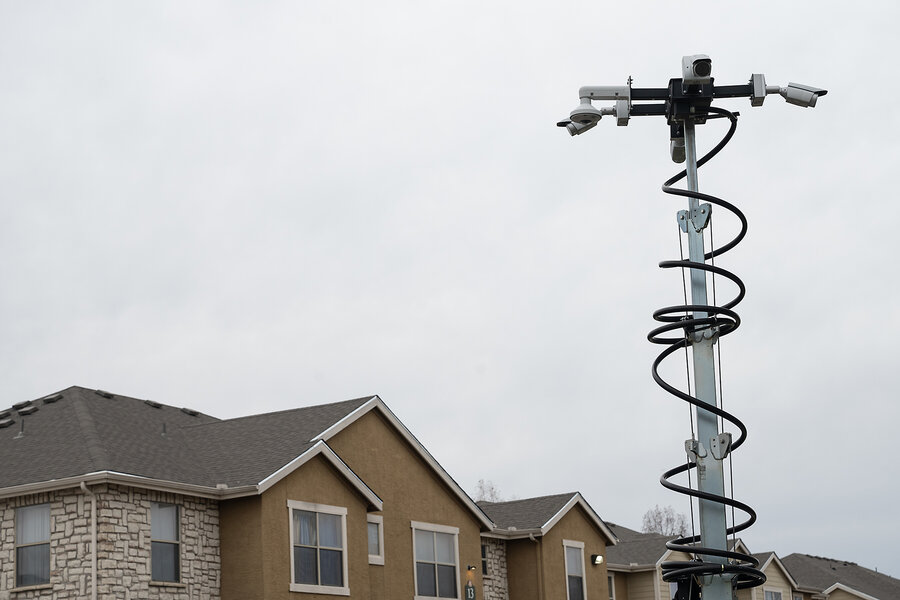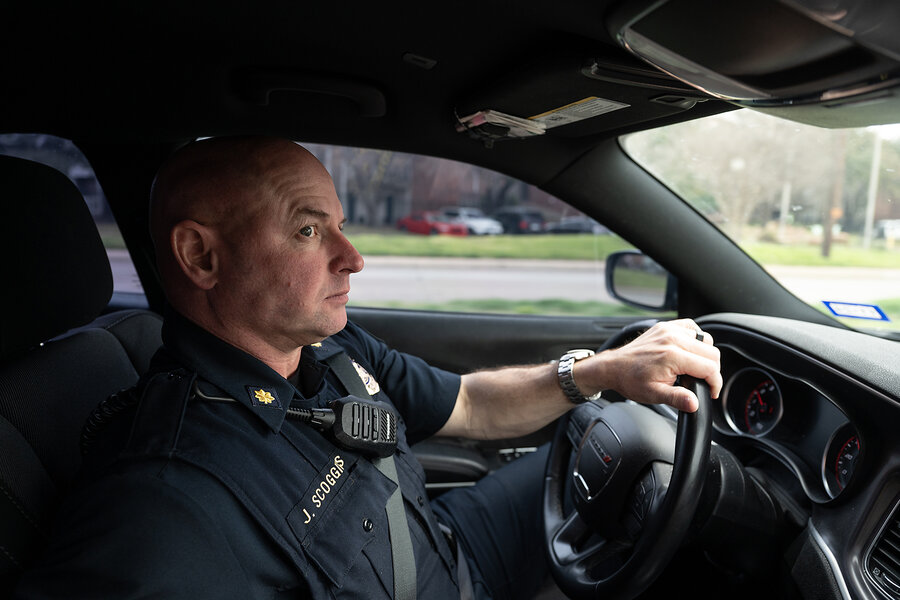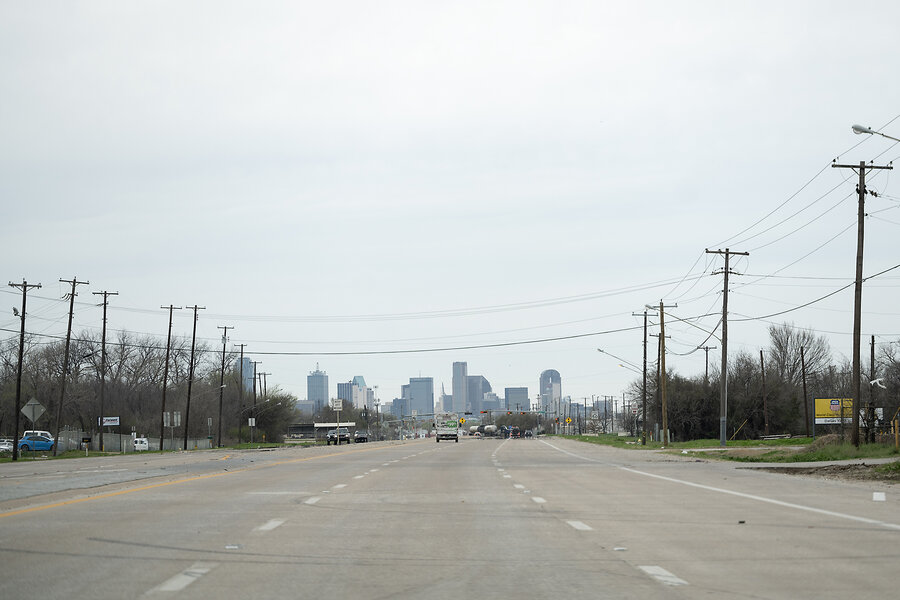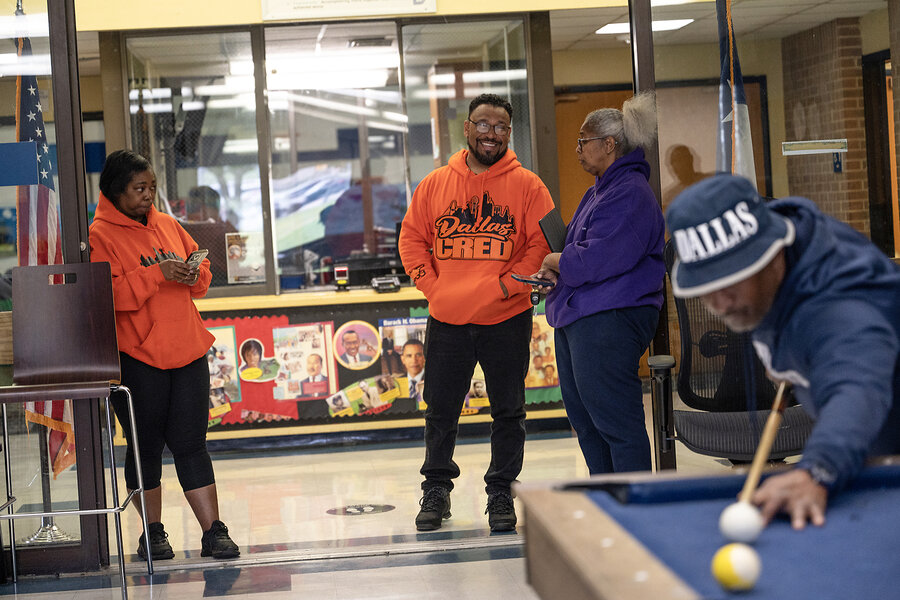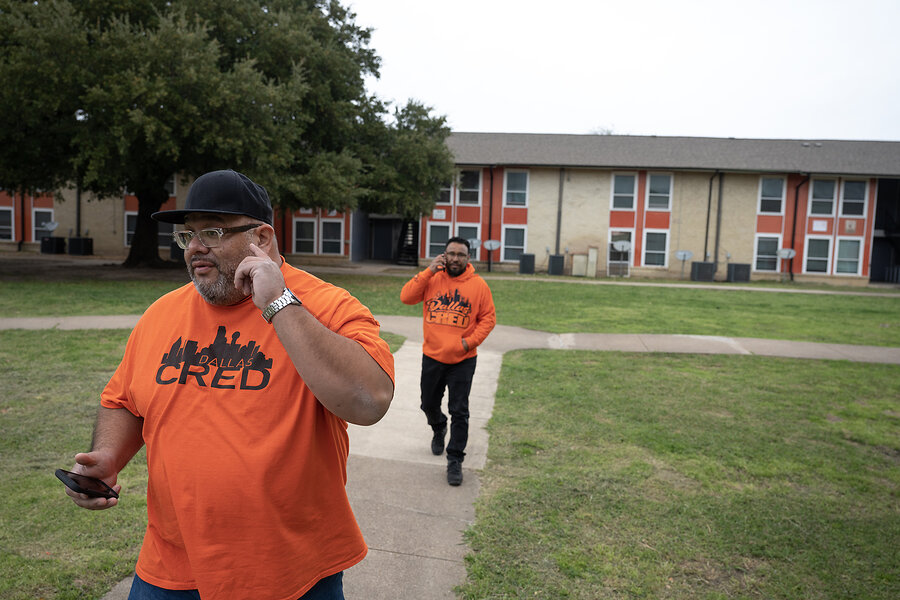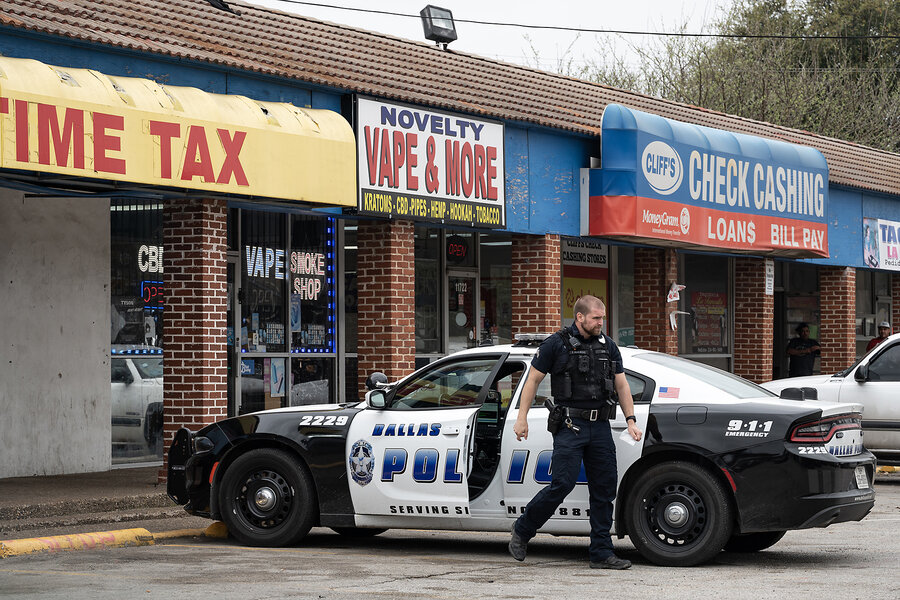Why Dallas wants police to adopt a ‘light footprint’ while fighting crime
Loading...
| DALLAS
When Maj. Jason Scoggins first heard about the new “light-footprint” strategies for the Dallas Police Department, he was skeptical.
“You turn on your cruise lights and you’re there for 15 minutes, and that’s supposed to deter crime?” Major Scoggins recalls thinking.
Why We Wrote This
A story focused onWho is responsible for the safety of a community? Police are an obvious answer. But in Dallas, efforts to address violent crime go beyond the usual suspects.
He’s a second-generation Dallas police officer, and he and his father represent a combined half-century of policing experience. But this strategy “was not something that I’ve ever seen,” he says.
The practice hinges on the idea that police presence alone can deter violent crime when “hot spots” are at their hottest. So officers are instructed to simply make themselves visible.
“If this ... reduces violent crime,” Major Scoggins says, “sign me up. I’m all for it.”
But law enforcement is just one part of a new multipronged approach to fighting violent crime. The city is also tapping the expertise of community organizations and local leaders to interrupt violence and to help coax offenders to enroll in programs to stabilize their lives.
“What’s important is what it’s not,” says Michael Smith, a criminologist at the University of Texas at San Antonio. “This isn’t police officers getting out of their cars, stopping everything that moves. It’s a modern, 21st-century, light-footprint crime reduction strategy.”
On a frigid late-February afternoon this year, fighting violent crime has brought Victor Alvelais to a fast-food drive-thru here in the southern part of Dallas.
After his chicken tenders finally arrive, he drives a few minutes down the road to the scene of a recent crime. A few weeks earlier, a gunman shot through a fence and wounded five children at an apartment complex in South Dallas.
Within two days of that shooting, Mr. Alvelais was there. The director of Dallas Cred, a local violence intervention group, he’d already been meeting with two teenage brothers who live there, talking them out of picking up their own weapons and getting revenge.
Why We Wrote This
A story focused onWho is responsible for the safety of a community? Police are an obvious answer. But in Dallas, efforts to address violent crime go beyond the usual suspects.
On this afternoon, he’s still responding. He’s with three other members of Dallas Cred this time, each of whom are wearing the organization’s bright-orange T-shirts, as well as a reporter he agreed could tag along.
They coax the brothers onto a porch outside their ground-floor apartment. It’s cold, so they’ve draped themselves in thick blankets. Juan Javier Pérez, a member of the team, throws some friendly shade, calling them “soft” for shivering under blankets while he’s wearing shorts. (Mr. Pérez is from the colder climes of Michigan.)
The conversation turns serious. They admonish the younger brother for picking up an assault charge. They ask him to let them know when he has a court date so they can talk to the judge.
It’s too cold for a longer conversation, and they shuffle back inside. But Mr. Alvelais says this was a productive meeting. The brothers still seem receptive to their emphasis on nonviolence. They listen to him. Perhaps they even trust his “cred,” or credibility, since he served nearly 30 years in prison for a homicide.
Just as he begins to drive away, the older brother runs out and stops him. Walking over to the driver’s window, he quietly tells Mr. Alvelais his family could use some food. So he heads to the fast-food drive-thru, orders more chicken tenders, and brings them back to the brothers.
“It’s a little thing,” Mr. Alvelais says. “A hot meal on a cold day, it goes a long way.”
Since 2021, Dallas has been taking approaches like violence intervention to make the city’s wider efforts to fight violent crime more effective. Relying on “trusted messengers,” violence intervention programs seek to build community relationships that address violent crime before it happens. Cities such as Philadelphia, Baltimore, Chicago, and others across the United States have included such programs in their law enforcement budgets, with each asking, can law enforcement evolve to be more of a community effort?
Those at Dallas Cred believe it must. “[The police’s] responsibility is to react to a crime, arrest the perpetrator, and leave,” says Mr. Alvelais. “They can’t be in the midst of the communities trying to eradicate this way of thinking, or prevent any sort of retaliation once it happens.”
“Violence is an effect; it’s not the cause” of crime, says Untruan Grant, another member of the group today. “Really, nobody wants to be in trouble, but sometimes we feel like that’s the only resort. We’re giving them other resorts to be able to take, and that’s by counting on us.”
A new approach
In Dallas and other cities in Texas, however, efforts to include the wider community in addressing violent crime are just one part of a major rethinking about law enforcement. Criminologists and policymakers in the Lone Star State have been in the process of initiating new multiyear and multipronged approaches to law enforcement, drawing on 50 years of research into the nation’s evolving policing techniques.
Their new approaches have included embracing what have often been the controversial ideas of “hot spots policing.” In a technique pioneered in Minneapolis and exemplified by New York City’s CompStat program in the 1990s, police first meticulously map crime patterns throughout the city and then focus their resources on areas in which violent crimes occur most often.
They’ve also begun to include another technique pioneered in New York: “broken windows policing.” Also a decades-old strategy, this kind of policing includes removing signs of disorder and blight as officers aggressively target minor crimes like vandalism and loitering. According to the theory, a focus on smaller problems helps prevent more serious violence and mayhem.
Both techniques have been vigorously contested by critics who point out that this kind of policing often floods Black and Latino neighborhoods with police, placing them under much more intense scrutiny and causing conflict and inequities.
But in Dallas and other cities in Texas, officials say they are trying to avoid the mistakes of the past. “It won’t necessarily be all police,” says Robert Blanton, an assistant chief with the San Antonio Police Department. “It’s much more comprehensive than the hot spots [idea]. ... These are going to be much more thoughtful, or active, issues.”
Focused deterrence
This more comprehensive approach to public safety also includes an idea known as “focused deterrence,” which was pioneered in Boston in the 1990s. Focusing on a small number of “key” violent offenders, an array of law enforcement officials and community leaders brings such offenders into a room and, together, works to convince them to turn their lives around. Police, prosecutors, community members, crime victims, nonprofit groups, and former criminals marshal their efforts to address the roots rather than the effects of violent crime.
If they cooperate, the community members and nonprofit groups are here to help them. Former criminals are there to tell them it’s possible. But if they continue to reoffend, police and prosecutors tell them they will be sent to prison for as long as possible.
These varied strategies have never been implemented together as part of a long-term coordinated plan, says Michael Smith, a criminologist at the University of Texas at San Antonio, who helped design the multipronged plan for Texas jurisdictions. These strategies, though controversial, have been adapted in light of the negative effects they’ve had, he says.
“What’s important is what it’s not,” Dr. Smith says about Texas’ new approaches. “This isn’t police officers getting out of their cars, stopping everything that moves. It’s a modern, 21st-century, light-footprint crime reduction strategy.”
From skepticism to hope
When Maj. Jason Scoggins first heard about the new light-footprint strategies for the Dallas Police Department, he was skeptical.
Stocky, with a shaved head and a Texas drawl, Major Scoggins is a second-generation Dallas police officer. He and his father represent a combined half-century of policing experience, but this particular hot spots strategy “was not something that I’ve ever seen,” he says.
Using data analysis to identify a small number of high-crime locations – often as small as a street corner or apartment building – supervisors tell officers not to make any arrests or do any kind of enforcement, really. Their presence alone, according to criminologists, should deter violent crime when these hot spots are at their hottest. They are instructed to simply announce their presence.
“At first it sounded funny,” Major Scoggins says. “You turn on your cruise lights and you’re there for 15 minutes, and that’s supposed to deter crime?” Still, he was willing to give it a shot. “If this is [that] simple ... and it deters crime and reduces violent crime? Sign me up. I’m all for it.”
After the program launched in 2021, violent crime dropped 53% in the hot spots and 14% citywide in the first six months, the department reported. San Antonio, which started the plan last year, reported a 44% drop in violent crime in hot spots.
Melissa Cabello Havrda, a member of the San Antonio City Council and chair of its Public Safety Committee, was skeptical of the crime plan at first. “But I was hopeful, and it turns out I had a reason to be hopeful,” she says.
Residents of Edgewood, a neighborhood in her district on the city’s west side, were also skeptical. The area has one of the highest crime rates in the city, and last year its school district recorded more violent student offenses than any other. But as the residents have been seeing more police patrols in the past year, now they’re telling her they feel safer, she says.
“That’s a big win in my book,” says Councilor Cabello Havrda. “Hot spots isn’t meant to be a solution on its own, and I think they understand that.”
The hope is that this first, entirely police-driven phase of the multipronged plan can lay the groundwork for the later and longer-term techniques to succeed.
“This strategy builds over time,” says Thomas Abt, a professor of criminology at the University of Maryland. “It starts with very simple interventions ... and then it adds increasingly complex interventions on top. That’s very exciting, and I think it’s very smart,” he says. “You need a balanced set of enforcement and nonenforcement strategies. It’s very important to recognize that police are not the only people responsible for maintaining public safety.”
Dallas’s approach to “broken windows”
Like many in Dallas now, Kevin Oden doesn’t fit the traditional crime-fighting profile. But after cutting his teeth overseeing Super Bowls, natural disasters, and disease outbreaks, he’s at the forefront of Dallas’ efforts to make public safety a citywide responsibility.
Head of the city’s Office of Integrated Public Safety Solutions, Mr. Oden is responsible for how Dallas implements its version of the broken windows theory. In the past, the strategy called for police to crack down on minor offenses as a way to disrupt and deter more serious offenses. Inspired by research in Philadelphia, Mr. Oden believes environmental improvements in an area can also decrease violent crime.
So his agency has trained teams of code inspectors to join the efforts to help prevent violent crime. They fix gates and fences, improve public lighting, and relandscape crime-prone areas like the back corners of apartment complexes. They clean vacant lots, remove abandoned vehicles, and install security cameras outside businesses. They also make sure vacant buildings are inaccessible – and without broken windows.
Mr. Oden’s office also works with Dallas Fire-Rescue, Park and Recreation, and even Water Utilities to bring resources and security to high-crime areas. His office also hires violence interrupter programs like Dallas Cred, investing about $1 million a year in the work.
“By doing those things ... you really turn around the narrative of risk in an area,” Mr. Oden says. “And you do it without having to do additional policing or tie up resources.”
But there is a limit to how much police and civilian agencies like his can do to tackle violence.
“Ultimately, all of these areas share the same common need, and it’s investment in housing, investment in economic opportunity, income growth,” he says. “The long-term [solution] is to make the investments the way that they probably should have been done a long, long time ago.”
He also helps coordinate the city’s new focused-deterrence efforts, hiring agencies like the South Dallas Employment Project.
Its managing partner, Wes Jurey, is another unlikely crime fighter. Gray-haired and mustachioed, he looks more like a university professor than like a man who picks up the phone at 3 a.m. to make sure you get a bed at a homeless shelter. But he’s been working to help the dozens of participants in Dallas’ focused-deterrence program, as well as their families.
Fifty-one people have joined the program, which was launched in June last year. Coordinating with other nonprofits and government agencies, Mr. Jurey has helped at least 31 clients connect to a total of 166 services. So far, only one participant has been rearrested, but not for a firearm-related or violent offense.
Many of them “got in trouble because of other circumstances that are a little bit beyond their control,” Mr. Jurey says. “It’s difficult to challenge that. And yet they’ve committed a crime, and they’re going to have to take the consequences of that. We want to help them not commit another crime,” he adds. “But you have to get down to, what are the underlying causes? ... It takes it all. It’s not just the job. It’s not just finding a place to sleep.”
From menace to mentor
Antong Lucky knows a lot about those underlying causes.
He’d never worked with law enforcement until last summer, when he agreed to share his story with participants in Dallas’ focused-deterrence program. It’s exciting for him, he says, because the program is a microcosm of what he thinks public safety should be. He calls it “a NATO,” a citywide alliance committed to reducing violent crime.
His father went to prison when he was 9 months old, and his mother worked long hours to provide for them, even as drug dealers worked outside his front porch and bullies and gang members shadowed him around his South Dallas neighborhood.
In school he had been an honor roll student. But outside school he quickly learned that he had to be something else. By the time he reached high school, he was a leader in a notorious gang, the Bloods.
“As a kid, the law of self-preservation kicks in, so you start putting on what you think you’re supposed to be,” Mr. Lucky says. “Then next thing you know, you’ve created a gang. Next thing you know, you’re into drugs. Next thing you know, you’re standing in front of judge who’s saying you’re a menace to society,” he says.
“That speaks to a lot of kids across the country in urban communities,” he continues. “It’s easy to say these kids [are] just dangerous from the start, and they’re bad and they’re killers. But it don’t happen like that,” he adds. “No one wakes up and says, ‘This is what I want to be.’ Sometimes your circumstances can be strong to convince you to front like you’re that, to pretend like you’re that. And if you pretend long enough, you just end up being it.”
After a long prison sentence, Mr. Lucky committed to turning his life around. That involved negotiating a truce between the Bloods and the Crips, a rival gang, in 2000. And for decades, he’s worked to keep the peace in Dallas’ high-crime communities. Then the city hired him to help with focused deterrence.
Since Dallas implemented this plan, three other cities have followed suit. The results so far have been encouraging, albeit mixed. Dallas saw an increase in homicides last year compared with 2022, but most other kinds of violent crime have decreased since 2021.
Mr. Lucky, for his part, is optimistic. When he was growing up, “these types of efforts didn’t [exist]. They judged us before even trying to help us,” he says. “We’re not there yet. I think we’re getting there. We need an alliance of all types of people to help.”
In many ways, however, these ideas are still experiments. In 2021, the city hired Dallas Cred, which is supported by the national nonprofit Youth Advocate Programs Inc., but that contract expired at the end of 2023. The staff of the violence interruption group dropped from a team of 12 working in four focus areas across the city to a team of just four working in two focus areas today.
But violent crime in the areas they worked decreased by 22% over those two years, the organization says. Both it and city officials say they hope to work together again.
An old-school stakeout
On a quiet, warm February morning on Ferguson Road in East Dallas, the last police officers are moving into position.
Major Scoggins is watching from an unmarked car as a skinny young man in shorts and a beanie sweeps the sidewalk outside a convenience store. Across the street, a teenage boy ambles along the sidewalk, sits at a bus stop, and glances left and right.
For all the new emphasis on light-footprint policing and community partnerships, today’s operation is an old-fashioned stakeout. A team of police officers, many in plainclothes and unmarked cars, is waiting to make its move to disrupt the area’s destructive fentanyl trade.
Suddenly, the officers descend. But even that is quiet. They stop and frisk a few of the men outside the convenience store, including the sweeper.
Plainclothes officers talk with the suspects, asking for information. Others search them, unsuccessfully, for fentanyl. The officers discover the sweeper has an outstanding warrant for arson, and proceed to arrest him. Residents of nearby apartment complexes stop to watch and then move on. There are morning errands to run, and this street corner is no stranger to crime and violence.
It’s the kind of policing that has generated national controversy in recent years. But residents here have long complained about not having enough police around as dealers peddle drugs and fight for turf.
“The people that are there that are not contributing to the crime, they’re just trying to live their normal lives,” Major Scoggins says. “They know why we’re there, and they’re thankful. But then we also need to show how invested we are in that area to make it a safe place for citizens to live.”
Still, the tensions between police and high-crime communities remain a critical issue for departments across the country, experts say. But the kinds of new approaches in Texas and other states are striving to fight violence with more than police work and criminal convictions.
“In the past, it was always about relying on policing,” says Thaddeus Johnson, a fellow at the Council on Criminal Justice and an assistant professor at Georgia State University. “But how do you make sure you have a system that salvages life rather than destroys it?”
Editor's note: This story has been updated to clarify the organizational structure of Dallas Cred. It is a local organization supported by the national nonprofit Youth Advocate Programs Inc.





